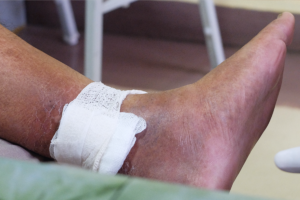Venous leg ulcers are a type of chronic wound that commonly occurs on the lower legs. These wounds can be painful, unsightly, and difficult to treat, making them a major burden for patients and their families alike. Some can fester for years without improving.
While venous leg ulcers can be caused by a variety of factors, one of the most common reasons why these wounds may not heal is related to the underlying vein disease that caused them in the first place.

What Causes Venous Leg Ulcers?
Vein disease, also known as venous insufficiency, occurs when the valves in the veins of the legs do not work properly. Normally, these valves prevent blood from flowing backwards in the veins, but when they become weakened or damaged, blood can pool in the legs and cause a variety of problems. This can lead to symptoms such as swelling, pain, and skin changes, including the development of venous leg ulcers.
Why is My Leg Ulcer Not Healing?
Venous leg ulcers are typically located on the lower leg and are characterized by a shallow, irregularly-shaped wound with a red, inflamed border. These wounds can be difficult to heal because they are often caused by an underlying problem with the veins, which can lead to poor circulation, reduced oxygen supply, and impaired immune function in the affected area.

Treating Leg Ulcers That Won’t Heal
When it comes to treating venous leg ulcers, the underlying vein disease must be addressed in order to achieve successful wound healing. This typically involves a combination of compression therapy, which helps improve circulation in the legs, and procedures to address the underlying vein disease.
Compression therapy involves the use of special stockings or bandages to help improve circulation in the legs. This can help reduce swelling and improve blood flow to the affected area, which can help promote healing of the wound. In addition, procedures such as radiofrequency ablation (RFA) or Varithena can be used to address the underlying vein disease, which can help reduce the risk of recurrence and improve overall wound healing.
While venous leg ulcers can be frustrating to deal with, it is important to work with a healthcare provider who specializes in the treatment of these wounds. By addressing the underlying vein disease and using appropriate wound care techniques, it is possible to achieve successful healing and reduce the risk of recurrence. If you are struggling with a venous leg ulcer, don’t hesitate to seek help from a qualified healthcare provider who can help you develop a personalized treatment plan to address your specific needs.